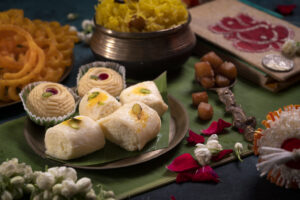Authentic Mumbai Vada Pav Recipe – A Taste of India
Cuisine: Mumbai, India
Vada Pav is a beloved street food from Mumbai, characterized by a spiced potato filling enveloped in a gram flour batter, deep-fried to golden perfection, and served in a soft pav (bread roll). This iconic dish, often referred to as the ‘Bombay Burger,’ features a sandwiching of flavor and culture, making it a sensational snack loved by many. Traditionally enjoyed during monsoons or as a quick bite any time of day, each bite bursts with flavor, a crispy texture on the outside, and a soft, warm interior.
Table of Contents
ToggleThe versatility of Vada Pav can also be seen through its various incarnations across the region. For instance, the version found in roadside stalls in Mumbai might be served with chutneys ranging from spicy green chili to sweet tamarind. Variations like Jain Vada Pav exclude certain ingredients to cater to Jain dietary restrictions, while the Mumbai Pav Bhaji shares similarities yet emphasizes a spiced vegetable mash instead, showcasing the creative ways this dish can adapt to different palates. However, today, we’re focused on crafting the classic Vada Pav that captures the heart and taste of Mumbai!
Ingredients for Vada Pav
| Potatoes | 4 medium (boiled and mashed) |
| Green Chilies | 2 (finely chopped) |
| Garlic | 5 cloves (minced) |
| Ginger | 1 inch (grated) |
| Turmeric Powder | 1/2 tsp |
| Salt | to taste |
| Cilantro | 2 tbsp (chopped) |
| Gram Flour | 1 cup |
| Water | as needed |
| Pav Buns | 8 |
| Chutney | as per taste (green and tamarind) |
Preparation Method
Embrace the street food vibes as we prepare this delightful treat. Here’s how to bring the popular Vada Pav to your kitchen!
- In a large bowl, combine the boiled and mashed potatoes, green chilies, garlic, ginger, turmeric, salt, and cilantro. Mix well until fully combined.
- Shape the potato mixture into small round balls (patties).
- In a separate bowl, mix gram flour with water to form a thick batter.
- Heat oil in a pan for deep frying.
- Dip each potato ball into the gram flour batter and carefully place it in the hot oil.
- Fry until golden brown and crispy. Remove and drain excess oil on paper towels.
- Slice the pav buns horizontally, and inside each bun, spread green chutney and tamarind chutney as preferred.
- Insert the fried vada into the bun. Serve hot with extra chutney and fried green chilies.
Nutritional Information
| Calories | Approximately 250 kcal per serving |
| Protein | 4g |
| Fat | 10g |
| Carbohydrates | 37g |
| Fiber | 3g |
When and How to Serve
Vada Pav is an excellent choice for Kids as it makes for a delicious and filling snack. It is easy to pack in Office Tiffin, giving a taste of Mumbai’s street food culture even during a busy workday. The unique flavors make them a hit among all age groups, ensuring that they’ll be a favorite at family gatherings or a quick bite on the way to school.
Cultural Significance of Vada Pav
The roots of Vada Pav trace back to the bustling streets of Mumbai in the 1960s, with street vendors creating this delightful dish for the working class. As its popularity surged, Vada Pav became synonymous with Mumbai’s street food scene, often seen alongside the daily hustle and bustle of this vibrant city. Given its affordability and taste, it quickly won the hearts of the masses and became a staple snack.
Additionally, Vada Pav has woven itself into the fabric of city life, often seen during festivals or local gatherings, embodying the spirit of unity and joy. Some street stalls have become legendary, with families generating their own unique recipes passed down through generations. Imagine a local festival in Mumbai, with stalls lined up selling hot, steaming Vada Pavs, bringing people together over food and laughter!
If you’re contemplating a business venture in the food industry, the thriving popularity of Vada Pav presents a promising opportunity. With the growing trend of street food culture, opening a Vada Pav stall or franchise could cater to both locals and tourists. However, it’s essential to consider food safety regulations and the competition from existing food brands. Researching the unique selling points beyond just taste—like vegan options or fusion fillings—could offer a competitive edge in a saturated market.




